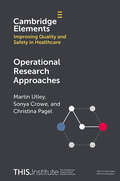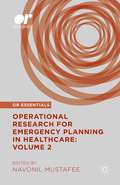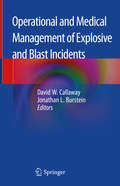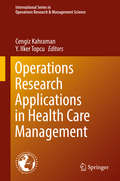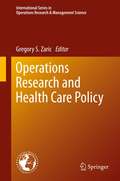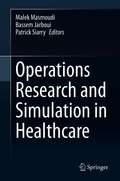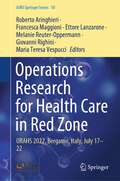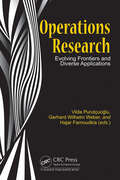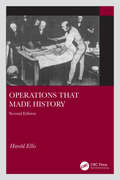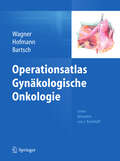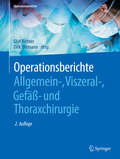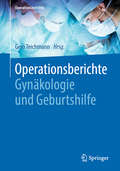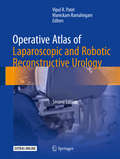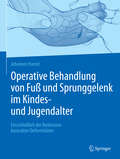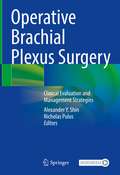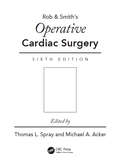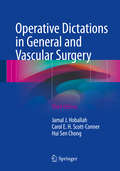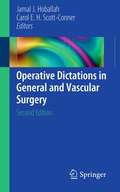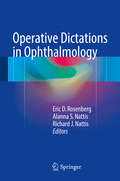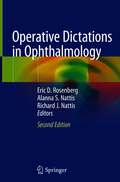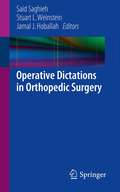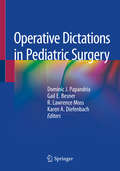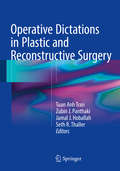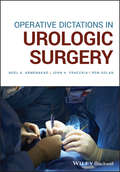- Table View
- List View
Operational Research Approaches (Elements of Improving Quality and Safety in Healthcare)
by Martin Utley Sonya Crowe Christina PagelOperational research is a collection of modelling techniques used to structure, analyse, and solve problems related to the design and operation of complex human systems. While many argue that operational research should play a key role in improving healthcare services, staff may be largely unaware of its potential applications. This Element explores operational research's wartime origins and introduce several approaches that operational researchers use to help healthcare organisations: address well-defined decision problems; account for multiple stakeholder perspectives; and describe how system performance may be impacted by changing the configuration or operation of services. The authors draw on examples that illustrate the valuable perspective that operational research brings to improvement initiatives and the challenges of implementing and scaling operational research solutions. They discuss how operational researchers are working to surmount these problems and suggest further research to help operational researchers have greater beneficial impact in healthcare improvement. This title is also available as Open Access on Cambridge Core.
Operational Research for Emergency Planning in Healthcare: Volume 2 (OR Essentials)
by Maysaa Husam JaberThis book presents a selection of studies that have applied Operational Research methods to improve emergency planning in healthcare, to include both A&E and public health emergencies like epidemic and natural disasters. The studies have delved into qualitative Operational Research like Problem Structuring, Critical Systems Thinking, Soft Systems Methodology, and Qualitative System Dynamics, and also quantitative techniques such as Monte Carlo Simulation, Discrete-event Simulation, and System Dynamics. These techniques have been applied for review and assessment of emergency services, for policy formulation and for facilitating broader public engagement in emergency preparedness and response. Furthermore, this book presents rigorous reviews on the applications of Operational Research in the wider healthcare context. This volume focuses mainly on emergency planning at the strategic level, whereas volume 1 focuses on planning at the operational level. The OR Essentials series presents a unique cross-section of high quality research work fundamental to understanding contemporary issues and research across a range of Operational Research (OR) topics. It brings together some of the best research papers from the highly respected journals of the Operational Research Society, also published by Palgrave Macmillan.
Operational and Medical Management of Explosive and Blast Incidents
by David W. Callaway Jonathan L. BursteinThis book provides a comprehensive overview of the medical and operational management of blast and explosive incidents affecting civilian populations. It incorporates global lessons learned from first responders, emergency medicine providers, surgeons, intensivists, and military specialists with deep experience in handling blast injuries from point of injury through rehabilitation. The book begins with background and introductory information on blast physics, explosion types, frequency, and perspectives from the military. This is followed by a section on prehospital management focusing on medical and trauma responses, triage, psychological consequences, and operational considerations. It then examines the roles of the emergency department and ICU with chapters on planning and training, surge capacity, resilience, management of common injury types, contamination, and ventilator strategies. The next section covers surgical treatment of a variety of blast injuries such as thoracoabdominal, extremity and vascular, and orthopedic injuries. The book then discusses medical treatment of various injury patterns including lung, abdominal, extremity, and traumatic brain injury. The final section of the book covers post-hospital considerations such as rehabilitation, mental health, and community resilience. Throughout, case studies of recent incidents provide real-life examples of operational and medical management.Operational and Medical Management of Explosive and Blast Incidents is an essential resource for physicians and related professionals, residents, nurses, and medical students in emergency medicine, traumatic surgery, intensive care medicine, and public health as well as civilian and military EMS providers.
Operations Management for Healthcare
by Jan Vissers Sylvia Elkhuizen Nathan ProudloveThis fully updated edition of the bestselling textbook on Health Service Operations Management provides an invaluable reference for students and researchers in the fields of healthcare management, operations management and patient flow logistics. Featuring theoretical frameworks and a comprehensive set of practical case studies, this book also covers subjects such as hospital planning and supply chain management in healthcare, quality assurance and performance management. Healthcare managers work together with healthcare professionals in a multitude of challenging scenarios. Trade-offs have to be made between waiting times for customers and efficient use of scarce resources, between quality of care and quality of services, between the perspective of a single pathway and the total system, and between the perspective of a single provider and that of a network of providers working together in the chain of primary care, hospitals, nursing homes and home care. This book guides healthcare students and professionals through a set of practical tools and resources, ranging from simple queueing models to more complicated analytical models, to help address these issues. The book can be used at an undergraduate level by introducing concepts, definitions and approaches, and at a postgraduate level through the application of approaches to operations management problems in healthcare practice. It will serve as a primary textbook for a health service operations management course module in a Master's program on healthcare management.
Operations Research Applications in Health Care Management
by Cengiz Kahraman Y. Ilker TopcuThis book offers a comprehensive reference guide to operations research theory and applications in health care systems. It provides readers with all the necessary tools for solving health care problems. The respective chapters, written by prominent researchers, explain a wealth of both basic and advanced concepts of operations research for the management of operating rooms, intensive care units, supply chain, emergency medical service, human resources, lean health care, and procurement. To foster a better understanding, the chapters include relevant examples or case studies. Taken together, they form an excellent reference guide for researchers, lecturers and postgraduate students pursuing research on health care management problems. The book presents a dynamic snapshot on the field that is expected to stimulate new directions and stimulate new ideas and developments.
Operations Research and Health Care Policy
by Gregory S. ZaricOperations research tools are ideally suited to providing solutions and insights for the many problems health policy-maker's face. Indeed, a growing body of literature on health policy analysis, based on operations research methods, has emerged to address the problems mentioned above and several others. The research in this field is often multi-disciplinary, being conducted by teams that include not only operations researchers but also clinicians, economists and policy analysts. The research is also often very applied, focusing on a specific question driven by a decision-maker and many times yielding a tool to assist in future decisions. The goal of this volume was to bring together a group of papers by leading experts that could showcase the current state of the field of operations research applied to health-care policy. There are 18 chapters that illustrate the breadth of this field. The chapters use a variety of techniques, including classical operations research tools, such as optimization, queuing theory, and discrete event simulation, as well as statistics, epidemic models and decision-analytic models. The book spans the field and includes work that ranges from highly conceptual to highly applied. An example of the former is the chapter by Kimmel and Schackman on building policy models, and an example of the latter is the chapter by Coyle and colleagues on developing a Markov model for use by an organization in Ontario that makes recommendations about the funding of new drugs. The book also includes a mix of review chapters, such as the chapter by Hutton on public health response to influenza outbreaks, and original research, such as the paper by Blake and colleagues analyzing a decision by Canadian Blood Services to consolidate services. This volume could provide an excellent introduction to the field of operations research applied to health-care policy, and it could also serve as an introduction to new areas for researchers already familiar with the topic. The book is divided into six sections. The first section contains two chapters that describe several different applications of operations research in health policy and provide an excellent overview of the field. Sections 2 to 4 present policy models in three focused areas. Section 5 contains two chapters on conceptualizing and building policy models. The book concludes in Section 6 with two chapters describing work that was done with policy-makers and presenting insights gained from working directly with policy-makers.
Operations Research and Simulation in Healthcare
by Patrick Siarry Bassem Jarboui Malek MasmoudiThis book presents work on healthcare management and engineering using optimization and simulation methods and techniques. Specific topics covered in the contributed chapters include discrete-event simulation, patient admission scheduling, simulation-based emergency department control systems, patient transportation, cost function networks, hospital bed management, and operating theater scheduling. The content will be valuable for researchers and postgraduate students in computer science, information technology, industrial engineering, and applied mathematics.
Operations Research for Health Care in Red Zone: ORAHS 2022, Bergamo, Italy, July 17–22 (AIRO Springer Series #10)
by Ettore Lanzarone Maria Teresa Vespucci Melanie Reuter-Oppermann Roberto Aringhieri Francesca Maggioni Giovanni RighiniThe book contains selected contributions from the 48th Annual Meeting of the EURO Working Group on Operational Research Applied to Health Services (ORAHS 2022) held in Bergamo, Italy, July 2022. ORAHS 2022 provided a network for researchers involved in the application of systematic and quantitative analyses to support planning and management in the health services sector, with the ultimate goal of pursuing good health and well-being. It was the ORAHS in the red zone, focused on the organization and reaction of health systems in the face of emergency situations such as the COVID pandemic. The questions addressed were, for example, how can hospitals and public authorities react to extreme scenarios by reorganizing their resources? How and to what extent do local health systems integrate hospitals to deal with a pandemic? How can Decision Support Systems for diagnosis and treatment help when battling a new virus for the first time? Contributions included a variety of methodological viewpoints (optimization, simulation, data analysis, predictive models, decision science, mathematical programming, machine learning, ...) and health services applications (hospital management, therapy calibration, analysis of statistical and epidemiological data, minimization of logistics costs, ...). This work strongly contributes to the Sustainable Development Goals (SDG) Programme.
Operations Research: Evolving Frontiers and Diverse Applications
by Gerhard Wilhelm Weber Hajar Farnoudkia Vilda PurutçuoğluOperational research (OR) methods are used in many fields of sciences like computer engineering, industrial engineering, social works, business management, medical studies and finance. This book, is the second book in the series of Operational Research (OR) books. It brings together the latest advances of these methods written by experts from all over the world. The book comprises 13 chapters and is split into four main parts, i.e., OR in supply chain management, OR in production planning and inventory management, OR in signal processing and OR in social sciences. The book contains recent methodologies and comprehensive reviews where necessary, so that readers can follow up to date progress in the field while observing various applications with large datasets. The data used in the book is available in public databases. Therefore, the reader can easily access them and try their own approaches for comparison. Furthermore, since the book covers the literature reviews in each chapter, readers can both follow other benchmark techniques in the field and learn the theoretical aspects of the selected methods. In conclusion, the book will be assist in the discovery of new avenues for novel researchers who are interested in OR methods.
Operations that made History 2e
by Harold EllisA notable surgeon and charismatic teacher himself, Professor Ellis has brought together in Operations that made History a fascinating collection of renowned surgical procedures each one illustrating a different aspect of the history of surgery.
Operationsatlas Gynäkologische Onkologie
by Rainer Hofmann Uwe Wagner Detlef K. Bartsch Jelena BoekhoffPro Jahr gibt es ca. 30.000 gynäkologisch-onkologische Neuerkrankungen in Deutschland, deren operative Behandlung und Versorgung häufig auch einer interdisziplinären Zusammenarbeit bedarf. Dieser Anforderung trägt das interdisziplinäre Herausgeber- und Autorenteam - bestehend aus Gynäkologen, Chirurgen und Urologen - Rechnung. Präoperative Überlegungen zu Notwendigkeit und Planung des Eingriffs gehen der schrittweisen Darstellung der OP-Techniken voran. Ausführlich und anschaulich werden sowohl Primäreingriffe als auch Operationen bei Rezidiven beschrieben. Eine Vielzahl hochwertiger intraoperativer Fotos und schematischer Zeichnungen illustriert die Interventionen. Zusätzlich sind jedem Organkapitel als Einleitung die aktuellen Leitlinienvorgaben vorangestellt. Eigene Beiträge zu Rezidivchirurgie sowie zu Rekonstruktionen, plastischer Defektdeckung und Komplikationen vervollständigen den Inhalt. Der Fokus des Buchs liegt immer auch auf der Verbesserung oder Erhaltung der Lebensqualität der Patientin.
Operationsberichte Allgemein-, Viszeral- , Gefäß- und Thoraxchirurgie
by Olaf Richter Dirk UhlmannZu über 200 Indikationen aus allen Bereichen der Allgemein-, Viszeral- , Gefäß- und Thoraxchirurgie zeigt dieses Buch an ausformulierten Beispielen, wie ein ausführlicher und korrekter Operationsbericht gestaltet sein sollte. Der Arzt in der chirurgischen Weiterbildung erhält damit eine praxisnahe Anleitung zum Verfassen der Berichte. Einführende Kapitel zum Berichtsaufbau und den rechtlichen Grundlagen vermitteln das nötige Hintergrundwissen. Die realitätsnahen Beschreibungen erleichtern dem Weiterbildungsassistenten zudem die Vorbereitung auf die Einzelschritte einer geplanten Operation. Die 2. Auflage wurde um weitere Berichte ergänzt, eine Sektion mit 50 thoraxchirurgischen Eingriffen ist neu hinzugekommen.
Operationsberichte Gynäkologie und Geburtshilfe (Operationsberichte)
by Gero TeichmannZu über 100 Indikationen der operativen Gynäkologie und Geburtshilfe zeigt dieses Buch an ausformulierten Beispielen, wie ein ausführlicher und korrekter Operationsbericht gestaltet sein sollte. Auch urogynäkologische und senologische Operationen sind berücksichtigt. Der Arzt in der gynäkologischen Weiterbildung erhält damit eine praxisnahe Anleitung zum Verfassen der Berichte. Einführende Kapitel zum Berichtsaufbau und den rechtlichen Grundlagen vermitteln das nötige Hintergrundwissen. Die realitätsnahen Beschreibungen erleichtern dem Weiterbildungsassistenten zudem die Vorbereitung auf die Einzelschritte einer geplanten Operation.
Operative Atlas of Laparoscopic and Robotic Reconstructive Urology
by Vipul R. Patel Manickam RamalingamThis updated title is the ideal reference book for residents and fellows, with step-by-step pictures and only the essential prose. The major part of the book is illustrated with magnificent photographs and diagrams depicting every step of a particular procedure. Instruments are clearly shown and have been photographed from both outside and inside the body. Chapters demonstrate accepted laparoscopic techniques that are the new gold standard in urology. Outcome analyses show that with laparoscopy one can achieve the same oncologic success as with open surgery but will less morbidity.
Operative Behandlung von Fuß und Sprunggelenk im Kindes- und Jugendalter: Einschließlich der Redression kontrakter Deformitäten
by Johannes HamelDieses Buch beschreibt die Behandlung der wichtigsten kinderorthopädischen Fuß- und Sprunggelenksdeformitäten und -erkrankungen, denen der in Klinik und Praxis tätige Orthopäde begegnen kann. Im Mittelpunkt steht die operative Therapie im Kindes- und Jugendlichenalter, zusätzlich wird die redressierende Frühbehandlung der kontrakten angeborenen Deformitäten dargestellt. Ein besonderer Schwerpunkt wird auf die bildgebende Diagnostik, die pedografische Funktionsanalyse und die Indikationsstellung gelegt. Die vorgestellten operativen und redressierenden Verfahren werden exakt beschrieben und anhand von didaktisch brillanten Grafiken sowie zahlreichen klinischen Fällen aus der langjährigen Praxis des Autors illustriert. Hierbei wird der aktuelle Stand der wissenschaftlichen Diskussion einschließlich von Literaturempfehlungen berücksichtigt.
Operative Brachial Plexus Surgery: Clinical Evaluation and Management Strategies
by Alexander Y. Shin Nicholas PulosFully illustrated and enhanced with accompanying video clips, this comprehensive text presents the clinical evaluation and management of brachial plexus injuries and reconstruction, both for adult patients and birth injuries. Divided into two main sections, part one covers adult brachial plexus injuries, discussing the relevant anatomy and biology, epidemiology, and associated injuries. The main focus, however, is on diagnosis – the clinical exam as well as neurodiagnostic and radiographic evaluation – and surgical management approaches and techniques, including nerve grafting and transfers, tendon and muscle transfers, and joint fusion. Related topics are presented in chapters on sensory reinnervation, neuropathic pain management, the role of amputation and prosthetics, and pre- and post-surgical therapy protocols. Brachial plexus birth injury is described in part two, also focusing mainly on diagnosis and management but with an emphasis on the fact that babies are not small adults and special considerations are warranted. This section concludes with chapters on the management of late complications and long-term sequelae.A comprehensive surgical text on brachial plexus injuries has not been previously attempted. Filling a large gap in the literature, Operative Brachial Plexus Surgery is the go-to resource for adult and birth related brachial plexus reconstruction for orthopedic surgeons, neurosurgeons, plastics surgeons, and their trainees.
Operative Cardiac Surgery (Rob & Smith's Operative Surgery Series)
by Thomas L. Spray and Michael A. AckerThe sixth edition of this acclaimed and established operative atlas continues to provide a unique level of comprehensive detail on operative surgery of the heart and great vessels.With an international list of authors, the chapters have been updated and complemented by the same high quality artwork that has established this operative guide as the gold standard reference for the cardiac surgeon. This new edition retains the format of initial principles and justification for the procedure, followed by preoperative investigations and preparation, the operative procedure, and postoperative management. New chapters have been added on the latest techniques such as minimal invasive surgery, robotic surgery and off-pump bypass surgery.The chapters are arranged in seven sections, with each section emphasising the overall management of patients, tricks of the trade of individual authors and discussion of technical and clinical judgement. With this new and updated edition, Operative Cardiac Surgery remains the pre-eminent operative guide to a full range of cardiac conditions. Print Versions of this book also include access to the ebook version.
Operative Dictations in General and Vascular Surgery
by Jamal J. Hoballah Carol E. H. Scott-Conner Hui Sen ChongThis text is a fully updated and revised third edition of a highly successful text. The format of this text is unique and has been very successful. A total of 286 short chapters organized into 24 Sections provide operative dictation templates for all of the common and the vast majority of the uncommon and even rare operations performed by general and vascular surgeons. Each chapter also provides a succinct synopsis of the operation through bullet-ed lists which include Indications, Essential Steps, Note these Variations, and Complications. The book thus serves two purposes: these operative dictation templates can be used verbatim when dictating the operative note for a procedure; and the book provides ready reference to the trainee going into the operating room to do the procedure for the first time, or to someone preparing for their Board examinations. Space for notes allows surgeons to personalize the book and turn it into a resource unique to their situation. Fully updated and expanded, Operative Dictations in General and Vascular Surgery, Third Edition includes significant additions that include flexible endoscopic procedures (now recognized as a core part of general surgery training and practice), single incision laparoscopic cholecystectomy, and robotic approaches to the rectum. The endovascular procedures have been significantly expanded, as have the approaches to venous disease and to A-V fistula creation. Operative Dictations in General and Vascular Surgery, Third Edition is intended for practicing surgeons, who may modify each template to reflect their own individual practice. It also serves as a concise reminder of essential steps in those operations that may be only rarely performed.
Operative Dictations in General and Vascular Surgery
by Jamal J. Hoballah Carol E. Scott-ConnerOperative Dictations in General and Vascular Surgery, Second Edition is intended to teach residents the principles of succinct and precise operative dictations for a wide spectrum of surgical procedures. Designed as a portable resource, the book provides typical dictations to guide the resident. Comprised of 226 procedures, this new edition comprises the majority of procedures commonly performed by general and vascular surgeons. For each procedure, a list of common indications is given. This list covers 95% of the situations in which a particular procedure will be used. A list of essential steps follows. These can be used to mentally rehearse the procedure before it is performed. The next heading, Note these technical variations, introduces a list that is intended to prompt the surgeon for particular things to note and dictate within the template. A list of possible complications that are typically associated with that particular surgical procedure follows. Finally, a template operative dictation is provided. Common opening and terminating sequences (for example, how to enter and close the abdomen) in all laparotomy dictations are included. The volume has two primary objectives. First, it is designed to serve as a source of model operative dictations that may be individualized and used as templates. Second, it is intended as an aide-memoir, giving the surgeon a short list of pertinent information about each procedure. Ample space is provided to allow each surgeon to add notes. By reviewing this introductory material before scrubbing on a procedure, the trainee surgeon will enter the operating room better prepared to participate actively and to learn as much as possible. At the end of training, this book, with the notes accumulated by the resident, will serve as an invaluable review resource analogous to the individualized notebooks many surgeons keep. Operative Dictations in General and Vascular Surgery, Second Edition is intended for practicing surgeons, who may modify each template to reflect their own individual practice. It also serves as a concise reminder of essential steps in those operations that may be only rarely performed.
Operative Dictations in Ophthalmology
by Eric D. Rosenberg Alanna S. Nattis Richard J. NattisThis book provides residents with a comprehensive review of surgical cases within the field of ophthalmology. Operative Dictations in Ophthalmology touches on important steps within each surgical case, indications for the procedure, possible complications, and a sample dictation. The review serves as both a preparation and debriefing for each surgeon, or surgeon in training, by improving comprehension time, cultivating surgical forethought, and refining post operative dictations.
Operative Dictations in Ophthalmology
by Eric D. Rosenberg Alanna S. Nattis Richard J. NattisThis timely second edition expands upon the first edition, working to provide physicians with a comprehensive review of surgical cases within the field of ophthalmology. Extensive updates have been made to existing chapters, along with new chapters on hot topics in ophthalmology inserted throughout the existing text. Featuring important steps within each surgical case, indications for the procedure, possible complications, and a sample dictation – the review serves as both a preparation and debriefing for each surgeon, or surgeon in training, by improving comprehension time, cultivating surgical forethought, and refining post-operative dictations.
Operative Dictations in Orthopedic Surgery
by Jamal J. Hoballah Stuart L Weinstein Said SaghiehOperative Dictations in Orthopedic Surgery is a valuable resource for teaching orthopedic surgical trainees and practicing orthopedic surgeons how to document their operative procedures. The book includes the majority of the commonly performed orthopedic procedures. For each procedure, a list of common indications is given, covering 95% of the situations in which particular procedures will be used, as well as a list of essential steps. This is then followed by a list intended to prompt the surgeon for particular details to note and dictate within the template, a list of possible complications that are typically associated with a particular surgical procedure, and templates of operative dictation that allow the surgeon to individualize their dictations. Ample space is also provided to allow each surgeon to add notes. Concise and easy to use, Operative Dictations in Orthopedic Surgery is a unique tool for orthopedics surgical residents and residents in practice that better prepares them to participate actively and learn as much as possible in the operating room.
Operative Dictations in Pediatric Surgery
by Dominic J. Papandria Gail E. Besner R. Lawrence Moss Karen A. DiefenbachThis book provides pediatric surgeons with a comprehensive, up-to-date compilation of surgical and endoscopic procedures in the form of operative templates and explanatory text to orient learners to the pertinent details and technical variations of the operation. Each chapter includes procedure-specific indications and risks that are relevant to the consent process. Chapters are written by experts in their fields that represent eight distinct surgical subspecialties. Appropriate emphasis is placed on minimally-invasive approaches to portray contemporary practice whenever possible. The result reflects the authors’ experiences while still addressing common technical variations to ensure that each chapter is broadly reflective of clinical practice. Operative Dictations in Pediatric Surgery is designed as a concise guide to the pediatric surgical trainee and practicing surgeon alike who care for children across the surgical spectrum.
Operative Dictations in Plastic and Reconstructive Surgery
by Jamal J. Hoballah Tuan Anh Tran Zubin J. Panthaki Seth R. ThallerThis text provides a comprehensive overview of operative dictations in plastic, aesthetic, and reconstructive surgical procedures, which will serve as a valuable resource for residents, fellows, and practicing surgeons. The book provides step-by-step operative details regarding all indexed plastic surgery cases that a resident is expected to be thoroughly acquainted with for his or her daily practice and examinations. Each case is preceded by a list of common indications, covering most of the situations in which particular procedures will be used, as well as a list of essential steps. Operative Dictations in Plastic and Reconstructive Surgery will serve as a very useful resource for physicians dealing with, and interested in the field of plastic surgery. It will also provide the related data for the newly minted practicing plastic surgeons. All chapters are written by authorities in their fields and include the most up to date scientific and clinical information.
Operative Dictations in Urologic Surgery
by Noel A. Armenakas John A. Fracchia Ron GolanOperative Dictations in Urology offers practicing and trainee urologists succinct and precise operative dictations for wide range of both common and unusual urologic procedures. The book gives a concise stepwise description of the main operations in urologic surgery, written in a standardized fashion using the most up to date and trusted resources.
